Despite the pressures of rapid development and a burgeoning tourist trade, Bali’s traditional culture, supported by a flourishing community of artisans, is thriving.
For tourists looking to take home a meaningful souvenir, there’s nothing better than an example of the island’s renowned arts and crafts.
While some cultures create objects exclusively for worship, the Balinese make art out of the most basic tools of daily life, as well as religious artefacts.
Beauty here is a part of life, from the lavish canang sari – a daily offering to the gods – to the carved wooden doorways leading to family homes.
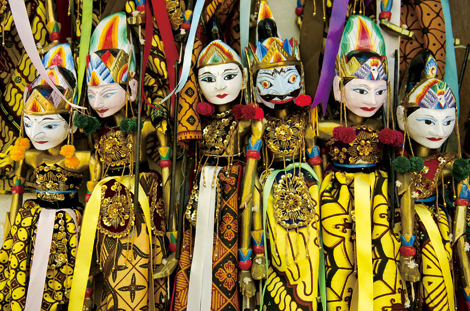
The Hindu outpost in predominantly Muslim Indonesia is unique, and this is reflected in the diverse and sophisticated art created here.
While tourism contributes a reported 65 per cent of the island’s GDP, craft culture also makes an important contribution.
Wooden handicraft exports totalled US$55.78 million in the nine months leading up to September 2012, according to Bali Statistics Agency, while textiles, furniture and handcrafts make up some 40 per cent of Bali’s exports.
With so much on offer, where are the best places to experience Bali’s artistic spoils?
Paintings
Balinese painting has evolved from religious worship, to a flourishing art form with Western influences and contemporary practices.
Traditional Balinese painting comprises the kamasan style, which tells a visual narrative and hails from the Klungkung area of the island, or the wayang style, which centres on the theatrical arts.
These types of paintings depict Hindu-Javanese epics such as the Ramayana or Mahabharata along with indigenous stories dating back to ninth century Javanese sculpture. Popular motifs include puppet figures, lush floral designs and landscapes.
The 1920s and 1930s ushered in a new era of Balinese art with the arrival of Western artists; tourism also exposed Balinese to new influences. These changes prompted a move from religious-centric art to works depicting expressions of rural life and increasingly individualistic styles.
Hotspots for painting include Batuan, where artists work in black and white to create mystical motifs related to sorcery and witchcraft.
In traditional Ubud paintings, depictions of Balinese life and drama are preferred, while in the Sanur school of painting, depictions of nature in vibrant pastel colours are more common.
For traditional and contemporary paintings, visit Tonyraka Art Gallery (Jl. Raya Mas No. 86 Mas Kedewatan Ubud Gianyar Bali, +62 3617 816 785, tonyrakaartgallery.com 10am – 5pm) in Mas, just outside of Ubud. The palatial compound is home to art exhibitions and also features tribal art collections from indigenous groups from across Indonesia. Its owner and curator, Tony Hartawan, will show visitors the gallery’s artist workshops on request and is eager to share his wealth of knowledge.
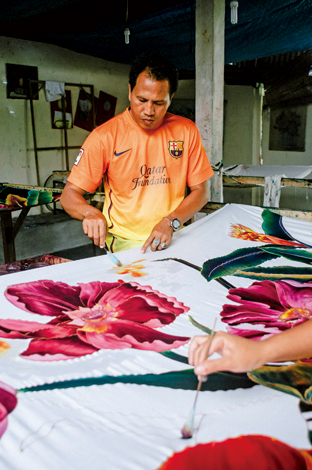
The Agung Rai Fine Art Gallery (JL. Pengosekan, Ubud, Kec. Gianyar, +62 361 974 228, agungraigallery.com9am – 5pm) offers quality traditional paintings and is the sister gallery to the venerable Agung Rai Museum of Arts (ARMA).
Neka Gallery (Raya Campuhan St. Kedewatan Village, Ubud, +62 361 975 074, museumneka.com 9am – 5pm) also features works from notable traditional Balinese artists, as well as those from foreign artists inspired by the beauty of Bali.
Meanwhile, the Sukawati and Ubud art markets are also teeming with paintings, but beware of inflated prices and copies. Take the time to scour the stalls looking for similar paintings or duplicates. Ask vendors about the artist and origins of paintings, or even request a studio visit to verify the validity of artist signatures for big-ticket items. Compare prices with several vendors before making your final purchase and don’t be afraid to start negotiations at 50 per cent of the initial asking price, as this is often roughly the cost of production. Be sure to bring cash for payment (Sukawati Art Market: Jl Raya Sukawati; 8am – 7pm; Ubud Art Market: Jalan Raya and Monkey Forest Road, Ubud; 8am – 7pm).
Woodwork
The Balinese have a long tradition of using natural media such as wood, stone, bone, horn and even gnarled tree roots for carving.
The art form dates back to Majapahit Kingdom (1293-1500) artisans who moved to Bali in the 14th century, bringing with them imagery of Hindu deities.
Traditional Balinese carving is largely created in the context of religion — depicting gods, goddesses and demons. Mask carving is a specialised form of woodcarving and is used for ritual dances for which 30 to 40 masks must be produced.
The Balinese also take time to adorn their furniture with elaborate scenes of religious texts and spiritual symbols. Small tabletop accents can take a matter of days to carve while large pieces of furniture can take several months. The era of commercialisation has only expedited the process and apprentices of master wood carvers can quickly create copies.
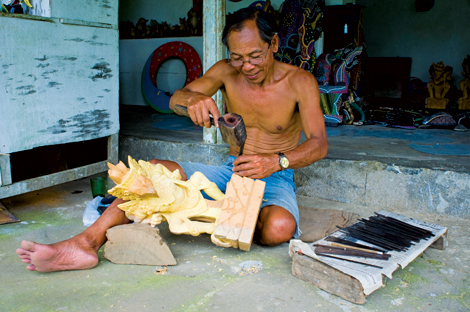
As with painting, Western influences are discernible in Balinese carving. For example, carvers moved away from idealised proportions of human bodies in favour of more abstract figures.
To observe artisans and purchase woodcarvings, head to Tegallalang, Pujung and Sebatu, all located within the Gianyar regency, which are home to multiple workshops. Just outside of Ubud, visit Mas village for high-quality carvings and interactive demonstrations in the showrooms and artist’s studios. Some showrooms will accept credit cards, but cash is preferred.
For a less pricey memento, cheap, mass-produced woodcarvings are abundant, but avoid wood that mimics teak and ebony with lacquer finishes. Unscrupulous vendors have taken to blackening lighter woods with polish in an effort to mimic the precious woods.
Textiles
Though batik was originally a Javanese textile technique, Bali has put its own mark on the tradition. Kawung batik features geometric patterns that appear to create the image of a lotus blossom with four leaves. Originally reserved for Balinese royalty, the cloth is now widespread.
Balinese artisans also produce a weft-ikat called endek. The ikat pattern is created by tying the threads of the cloth before it is woven and dyeing them so that selected areas do not absorb dye.
Kain prada is a beautiful and delicate cloth that is woven from silk and decorated with gold threads or gold leaf.
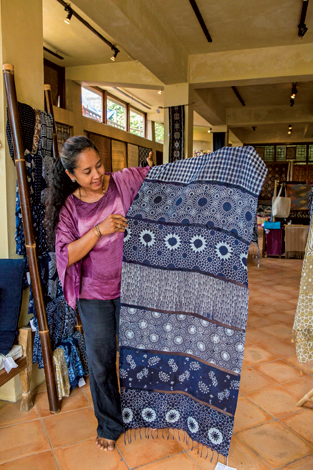
Catch artisans weaving ikat on handlooms at workshops in Gianyar, Denpasar and Tabanan. Most workshops have showrooms in the front for purchases and workshops in the back so visitors can observe the artisans weaving on handlooms.
For an educational visit to a batik gallery, try Widya’s Batik (J. Snwedari no. 61, Br. Tegallantang, Ubud, +62 817 976 4154, 8am – 5pm) where you can create your own batik masterpieces, observe masters on the loom or simply buy from the well-displayed gallery.
For an authentic market experience, visit the Kumbasari wet market on Jalan Gajah Mada. Along with woven bamboo and dried goods, there is a variety of Balinese printed batik and Balinese and Javanese hand-woven textiles. Be sure to haggle.
Precious metals
The Balinese have practiced metal work from as early as the fifth century BC, a result of trade with China, India and the Middle East.
The earliest metal jewellery was primarily copper with some silver, or a mixture of gold and copper.
An influx of Javanese noblemen and craftsmen came to Bali around the fall of the Majapahit Kingdom and the island became a centre for jewellery.
Legend has it that the Balinese learned their jewellery skills directly from the gods.
Silver is mined on Bali near Singaraja, but Celuk Village on the other side of the island is particularly famous for innovative gold and silver crafting, and both noble families and royalty have been known to enlist the services of artisans from this area.
More recently, Celuk has attracted young artisans from diverse backgrounds who train there. The village, located approximately four kilometres southwest of the Sukawati district, is particularly known for rings, bracelets, necklaces, and pins. Visit to observe silversmiths at work. There is also a smattering of shops.
Ritual of Fire (100x Jl. Raya Celuk) by the internationally acclaimed designer Desak Nyoman Suarti is not to be missed. Suarti originally opened her shop in New York’s Soho in the 1980s, creating a buzz about Bali. In Ubud, the revered Neka Art Museum displays beautiful traditional silverwork, including kris daggers.
For those with deep pockets who want to avoid haggling, visit the idyllic John Hardy compound in the foothills of Ubud. (Br. Baturning, Mambal, Abiansemal, Badung, 80352, +62 361 469 888, johnhardy.com; visits by appointment only).
The bamboo showroom has glittering cases filled with silver accoutrements, and helpful staff are eager to share the story of the jewellery brand, which was founded here in 1975.
How to get it home
You’ve fallen in love with a statement dining table and set of four beautifully carved chairs. Now how do you get it all home?
There are many shipping companies in Bali, but the most trusted names are LimaJari Cargo, MSA Cargo and Send From Bali. These shippers offer door-to-door solutions and in-house packing, as well as competitive pricing. By way of comparison, if shipping said table and chairs to Hong Kong by sea freight, quotes range from US$750-800, for air freight they range from US$1,900-2,500. If shipping by sea expect roughly two weeks for delivery and three days by air.
Paintings are easier to take home by yourself, but they should be properly packed for transit.
For unframed paintings a sturdy cardboard scroll can prevent folds or tears. For framed paintings, stick cello tape in an “X” shape on the glass to prevent it breaking in transit. Then, wrap the entire painting in a thick layer of bubble wrap to keep the painting secure. Find a box the same size of the painting and place the painting inside, with packing peanuts or crumpled newspaper to keep the painting from shifting inside. The painting should not be able to move inside the box.
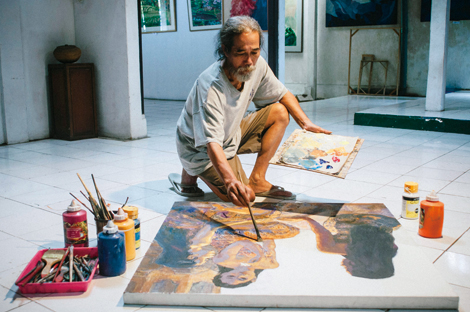
Get involved
Try your hand at woodcarving at the ARMA Museum (JL. Pengosekan, Ubud, Kec. Gianyar, 80571, +62 366 974 228, 9am – 5pm). This workshop allows participants to learn basic carving techniques with assistance from a local artisan. All tools and materials are provided and participants will come away with their own simple carved object. US$35 for two hours. armabali.com
n Watch batik artisans use hot wax to painstakingly define lines and symbols, and then try your hand. For classes with a sustainability slant, try Threads of Life (JL. Kajeng, No. 24, Ubud, Kec. Gianyar, 80571, +62 361 972 187, 10am – 7pm), a fair-trade business that works to alleviate poverty in rural Indonesia. The organisation cooperates with more than 1,000 women on 11 islands across Indonesia helping weavers form cooperatives to build financial security. Rp. 190.000 (US$14.70) per person for a minimum of four people. threadsoflife.com
n Though you can’t make your own silver moulds, you can observe all the stages of silver jewellery-making at the John Hardy compound. Start from the creative studio where artists hand render watercolour paintings of jewellery, to the factory floor where the silver is crafted in Hardy’s iconic chains and necklaces. Visit the Kapal Bambu showroom, a ship-shaped structure made entirely of bamboo. Visits by appointment only. johnhardy.com








